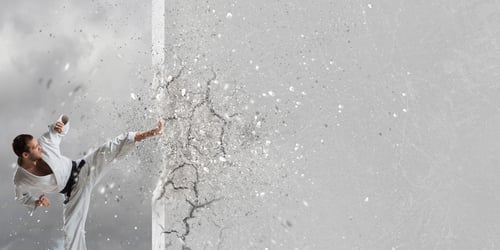"I fear not the man who has practiced 10,000 kicks once, but I fear the man who has practiced one kick 10,000 times."
- Bruce Lee
Kata is a Japanese word that means form. In martial arts, it refers to a detailed choreographed pattern of movements that are practiced alone or in groups. Kata was a way that training methods and the most successful combat techniques were passed from generation to generation. This systematic approach to training allows students to develop the ability to perform the movements with reflex-like precision; they become second nature. When someone is new to the practice, the moves will look difficult, but once they become a master, each action will look effortless and smooth. Repetition, precision, and attention to form are the prerequisites for mastery.
Toyota applied this principle to business and developed a methodology called Toyota Kata. What makes the approach unique is the focus on the process of improvement. The results are relevant, but equal emphasis is put on how those results were achieved and what was learned. The reason that Bruce Lee is more concerned about an imagined foe who practices the same kick 10,000 times is that it’s probably perfect, most likely predictable, and the opponent won’t have to think twice about what to do. That’s the ideal state of a workforce when it comes to executing incremental improvement.
In what is probably the most popular book on the subject, Toyota Kata: Managing People for Improvement, Adaptiveness and Superior Results, Mike Rother explains that it is not solutions themselves that provide sustained competitive advantage and survival over the long run, but the organization’s mastery of an effective routine for finding solutions to unpredictable problems.
One way to ensure that your organization applies a consistent form for improvement is to implement Kata software. Leveraging technology helps ensure that the approach to each change is uniform in its core elements, even if the problems being addressed vary widely. The Kata platform forms the structure upon which even the most complex issues can be addressed directly and effectively.
Here are some of the ways that happens.
Understanding the Challenges with Improvement Capture
You can’t develop perfect form in martial arts by doing a movement only a few times. Repetition is the key to success. That’s true for organizations that want to develop an improvement machine as well. They establish a routine for making incremental, but valuable changes to processes by practicing frequently. Kata software helps by making it easy for any employee to submit an opportunity for improvement and start the process of Kaizen, or positive change. Instead of only working on the challenges that capture the attention of top managers, Kata software enables bottom-up improvement, giving teams the chance to work on hundreds of opportunities.
Creating a Dependable Cadence
People are most comfortable with change when there is structure, and they know what to expect. Kata software helps establish a smooth workflow with a predictable sequence of events. When an opportunity for improvement is submitted, the system notifies the individuals who will need to assess it. Team members receive alerts when tasks are due, and when improvements are completed, leaders are notified so they can determine if that change should be applied more broadly.
Securing Organizational Knowledge
The Kata approach to improvement is very much about learning from past efforts. Coaches help team members replicate the improvement routines that have produce success and forsake those that have not been productive. Kata software provides a repository for all of the information about each attempt at positive change so that each new effort builds on the last and that data drives decisions.
Broadcasting Success
Coaching is an essential element of Toyota Kata. It is the responsibility of every manager to strive to make each team member better at finding and implementing opportunities for improvement. The best Kata software solutions feature improvement broadcasting capabilities so that each win can be shared widely, and everyone has the chance to learn. Recognition is so essential to employee engagement that it should be considered part of the improvement kata.
Calculating Impact
Finding the most effective approach to improvement for your organization means understanding how each completed project has impacted the organization in terms of cost reduction, revenue generation, customer satisfaction, safety, quality, and other critical metrics for your business. Kata software can support this by tracking the impact of change in both the short and long-term.
These are just some of the ways that Kata software enables organizations to implement a standard, yet adaptable approach to continuous improvement. As Mike Rother puts it, “If an organization wants to thrive by continually improving and evolving, then it needs systematic procedures and routines – methods – that channel our human capabilities and achieve the potential. Such routines would guide and support everyone in the organization by giving them a specific pattern for how they should go about sensing, adapting, and improving.”
That’s the key to unleashing the competitive advantage if Kaizen.





Add a Comment